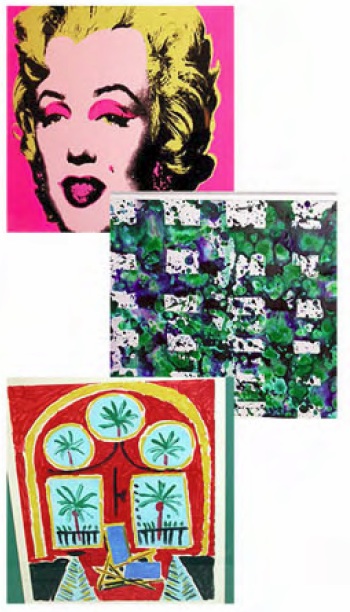One of the more exciting and varied types of pieces that I am called on to appraise, buy and sell for clients is prints. This is a broad category. So that we are on the same page, let’s start with some definitions.
Print Defined
A print is a piece of paper on which an image is imprinted from a matrix. With the exception of monoprints, print matrixes are created to produce several copies of the same image. The matrix is a piece of wood, stone or metal on which the original image is created. This image can be created by an individual artist, a craftsmen working under the direction of the artist / studio director or, by photographic transfer. Generally, those prints which are produced by photomechanical means are considered reproduction prints and are not collectible.
Prints fall into three general categories, defined by the type of matrix from which they are pulled. The categories are relief, intaglio and planographic.

Relief: Woodcut, Linocut, Wood Engraving
In a relief print, the image is transferred from the raised surface of the matrix. The artist cuts away what he or she doesn’t want printed. If you think about the potato prints you may have done in art classes or the rubber stamps you have played with, you will get the picture. Within this category are woodcuts, linocuts and wood engravings. (See Fig. 1 above)
Intaglio: Engraving, Etching, Drypoint, Mezzotint, Aquatint
In an intaglio (pronounced ‘in-tall-e-o’) print, the lower surfaces, the recessed areas, are what transfer the image. In this type of printmaking, the ink is applied across the plate, and the top surfaces are wiped clean. Damp paper is pulled through a high-impact press that forces the paper down into the recesses where the ink sits. One easy way to spot an intaglio print is to look for the platemark, an indented outer edge left when the size of the plate is smaller than the size of the paper. Within this category are engravings, etchings, drypoints, mezzotints and aquatints.
(See Fig. 2 below)

Planographic Lithograph, Serigraph: Reproduction print methods (halftone, xerography, collotype, photo-offset lithography, giclee)
As the name implies, planographic prints are created “at the plane” or surface of the paper. The matrix for a lithograph is a thick Bavarian limestone. The image is drawn onto the stone with a waxy substance and is chemically set into the stone. The stone is inked and paper laid on it and pressed. A stone will be used for hundreds of different prints. After an edition is pulled, the image is ground off and the stone is ready to be used again. (See Fig. 3)
A serigraph (also called silk screen) is created with a screen or series of screens that sit just above the paper. Each screen has the shape the artist wants printed in one color open and the rest of the screen blocked. The artist puts the ink on the screen and pushes it through with a squeegee. Serigraphy is additive. Each new screen adds another color, until the artist’s concept is complete. (See Fig. 4)
Most reproduction prints are photomechanical and are technically planographic since the plates are flat. Most are not collectible. These are photomechanical reproductions of an artist’s work done in another medium. They are printed in very high quantities and are sold cheaply. There is, however, a small group of prints in this category that have become collectible because of the popularity of the artist. Even though the editions are high, a secondary (resale) market does exist for a few artist’s prints. Some of the names that spring to mind are G. Harvey, Bev Doolittle, Robert Bateman and Paul Calle. When you run across an offset print and wonder whether the artist is collectible, it is easy to check the name and see if he/she falls into this category.

Spotting Reproductions
You will take a huge step forward in your connoisseurship of prints by learning to spot reproduction prints. There are basically two types, photomechanical offset lithographs and a printing method developed in the 1990’s commonly called gicleé. The first is easy to spot, and the second is a lot trickier. Offset printing was developed in the early part of the 20th century. This is the method of printing most high-volume, color printing that is done today. The paper is usually flat, not much tooth, and somewhat glossy. The image could be anything that can be photographed. If the image looks like an oil but is on paper and is flat, you are looking at an offset print. A simple tool, a jewelers’ loupe, will nail your identification. Under magnification, you can see that these images are made up of a mechanical dot pattern of red, yellow, blue and black dots. See Fig 5.
Gicleé is the latest addition to the printmaking methods. It was developed as capacity for modern color ink-jet printers to print on larger, more varied surfaces combined with the increased memory capacity of computers. The added memory translates into the ability to transfer more pixels per square inch. A pixel is basically a digital ‘image packet.’ When the pixel count per square inch is raised, the resolution of the image is raised. In giclee printing, a digital image can be transferred directly from the computer’s memory onto whatever surface the inkjet printer can handle. As the name inkjet implies, the color inks are blown directly onto the printing surface, producing a continuous tone similar to a photographic image. In the mid-1990’s, these printers had developed the ability to print onto virtually any surface, metal, watercolor paper, canvas, etc. Since the resolution is quite high on these prints, it can make them difficult for a novice to spot. If you suspect from other clues that the piece might have been produced in the late 20th century, you must consider the possibility of gicleé. Currently, gicleé printing is being used by most publishers of art for office environments. It is also being used by some photographers and by computer graphics artists to print their work. These prints can be printed on demand, meaning they do not have to be released in editions. They can be printed at many different sizes and on quite varied surfaces.
So, why no Fig. 6?
When viewed under magnification, there is no dot pattern to spot on a Gicleé print. The pattern is a granular, all-over tone that is very close to the look of a photograph and some other printmaking forms. These will be difficult for a novice to spot. If you suspect gicleé printmaking, have a good print appraiser take a look.
Prejudice against prints?
So, there are the basics. Now, I would like to discuss an odd phenomenon that I have noticed in the market —a real prejudice against prints among some dealers and collectors. Since I am a print enthusiast, I have always found this attitude puzzling. However, I understand some of the reasons that people shy away from prints.
Here’s the short list of objections and my responses to them:
- An original painting is easy to spot and identify. Whether the painting turns out to be oil or acrylic, the value is not affected much by mis-identification of the medium. But the term print is a broad category that covers everything from the collectible pieces on down to very inexpensive reproductions. To say that an item is a print is only the beginning of categorizing the piece by its medium. So, it takes more study time to properly identify prints. Without some hands-on experience and a guide, many people are intimidated by prints.
It is true that becoming familiar with prints takes more time and study than other areas. There are more mediums to become familiar with and be able to spot. But, that’s also what makes the field intriguing.
- Prints have been produced for many purposes and many different price ranges over the years. One of the market niches that has been filled by prints is that of the inexpensive decorative item for the home. With the advent of photomechanical printmaking in the late 19th and early 20th century, vast quantities of the same image can be easily and inexpensively reproduced. The number of these cheap prints available far exceeds the number of collectible prints on the market and leaves a potential serious collector with the seemingly daunting task of separating the good from the bad.
Yes, there are lots of cheap prints out on the market. But, there are also some incredible, collectible prints being offered at all levels of the market. Armed with knowledge, a savvy collector can pick up great prints in resale markets like estate sales, auctions and the like for a fraction of their retail value.
- Prints just aren’t worth enough money to bother with. Paintings are where the money is.
This is a fallacy. While it is true that when an artist works in more than one medium, the one-of-a-kind pieces will generally be priced higher than prints, the overall price range of prints is quite broad. A good print from a young, local artist might start as low as a few hundred dollars. On the other hand, a great print by a well-known master or contemporary artist might easily sell for $ 30,000-60,000, or more.

- Condition is a major factor in the value of a given print. Paper-born artwork is generally more fragile than paintings on canvas or panel. And, collectors of prints can be very particular about condition. So, it is just easier to look elsewhere.
Condition is important. Print collectors like pieces as close to original condition as possible. But, some damage can be corrected or minimized by a good paper conservationist.
So, should you start or continue to build your print collection? Are these pieces going to appreciate or languish in the market? The answer is that well-chosen prints that are taken care of can be wonderful pieces of art that give you pleasure for years and can also be great investments. How can we overcome the reticence to collect prints? The short answer is knowledge. The more you know about a given art medium the more fascinating you will find it and the better a collector you will become.
By Brenda Simonson-Mohle, ISA CAPP

 Born in Omaha, Nebraska in 1937 and raised in Oklahoma City, working artist Ed Ruscha (pronounced 'Rou-shāy') has experimented with a diverse range of media and styles throughout his career and is best known for his images depicting single words ostensibly suspended in space. His works have portrayed everything from gas stations, hordes of flies and boiling blood, to the scenery of downtown Los Angeles where he moved in 1956 and currently lives and works.
Born in Omaha, Nebraska in 1937 and raised in Oklahoma City, working artist Ed Ruscha (pronounced 'Rou-shāy') has experimented with a diverse range of media and styles throughout his career and is best known for his images depicting single words ostensibly suspended in space. His works have portrayed everything from gas stations, hordes of flies and boiling blood, to the scenery of downtown Los Angeles where he moved in 1956 and currently lives and works.




















